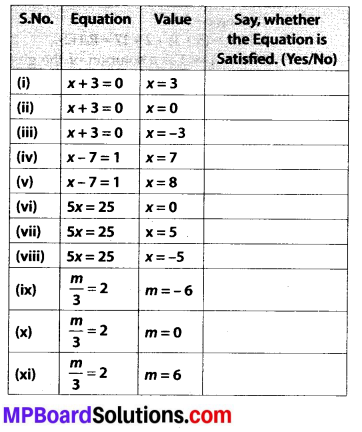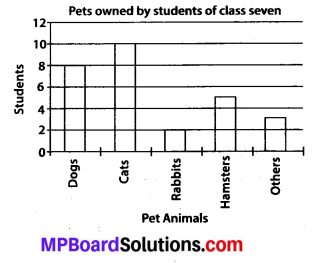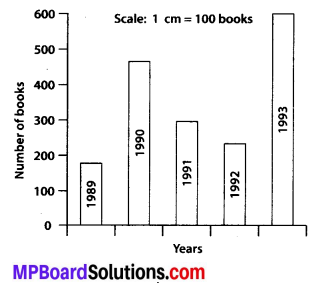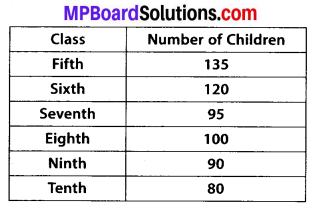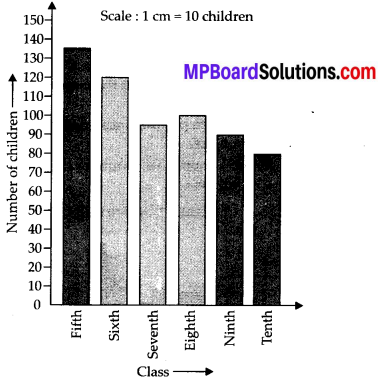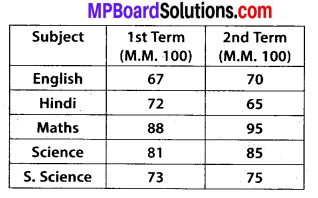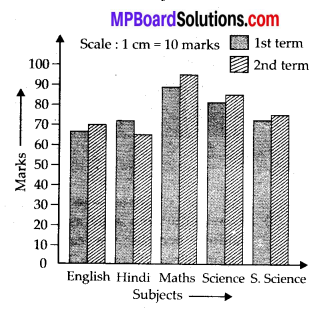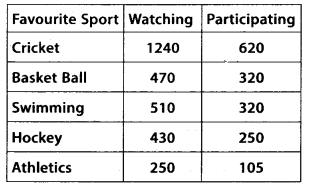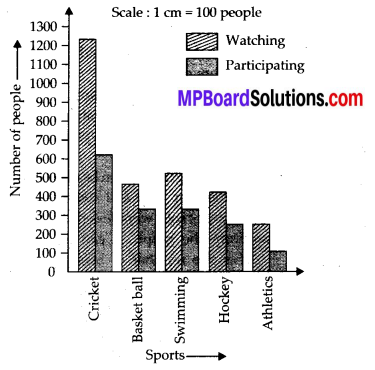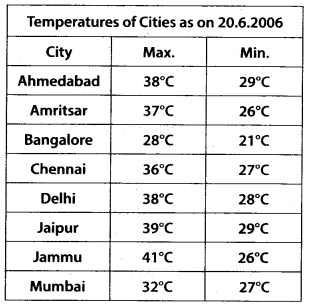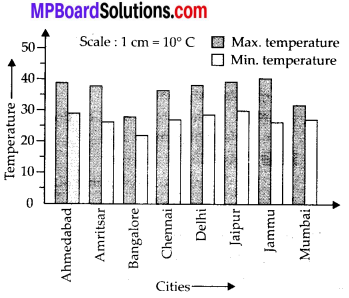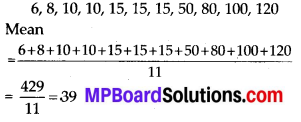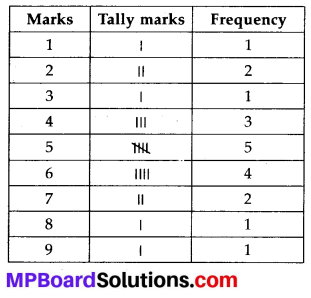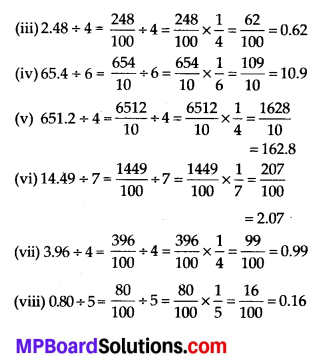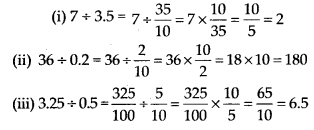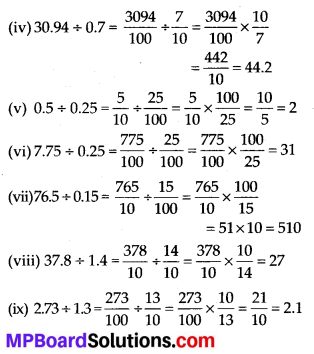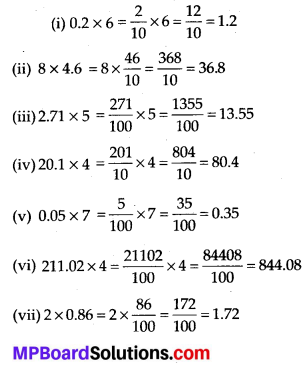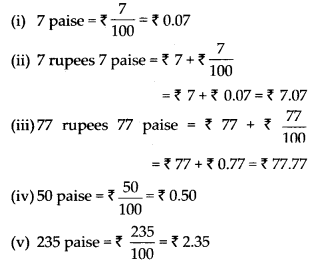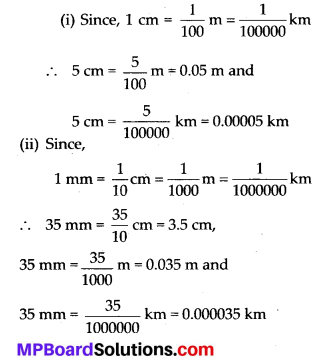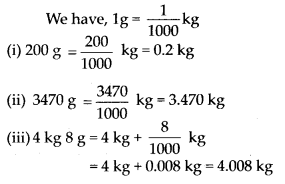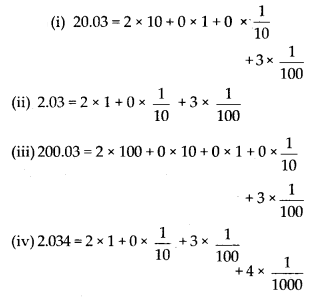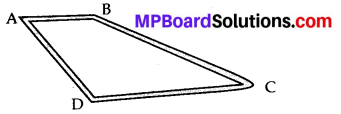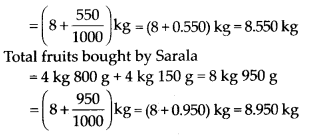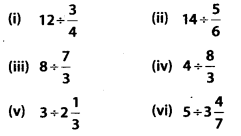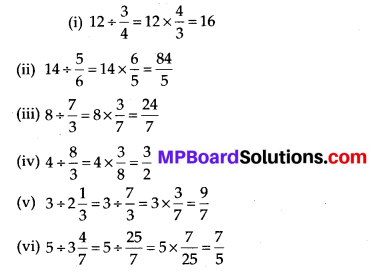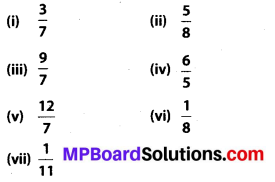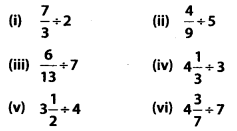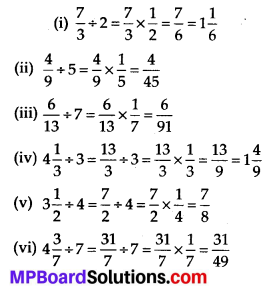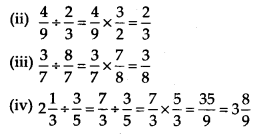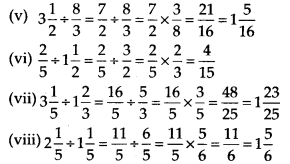MP Board Class 6th Hindi Sugam Bharti Solutions विविध प्रश्नावली 1
प्रश्न 1.
सही जोड़ी बनाइए
1. मंगल – (क) आंदोलन
2. असहयोग – (ख) कामनाएँ
3. राजेन्द्र सिंह – (ग) उर्वरा शक्ति
4. धरती की – (घ) मैगसेसे सम्मान
उत्तर-
1. (ख),
2. (क),
3. (घ),
4. (ग)
प्रश्न 2.
सही विकल्प चुनकर रिक्त स्थानों की पूर्ति कीजिए
1. मैं ……………………………………. तुझे था जब कुंज और वन में। (पुकारता/ढूंढ़ता)
2. भूमि के भीतर जो जल है, उसे हम उनके विधियों द्वारा ……………………………………. कर सकते हैं। (संक्षित/दोहित)
3. निर्मला ……………………………………. सा मुख लिए कमल को साथ लेकर स्कूल चली गई। (उदास/पुलकित)
4. महिमा महान् तू है, गौरव ……………………………………. तू है। (प्रधाननिधान)
5. चौरी-चौरा नामक स्थान में ……………………………………. घटना घटी। (सनसनीपूर्ण/उत्तेजक)
उत्तर-
1. ढूंढता
2. संरक्षित
3. उदास
4. निधान
5. सनसनीपूर्ण।
![]()
प्रश्न 3.
निम्नलिखित प्रश्नों के उत्तर एक-एक वाक्य में दीजिए.
(क) आधी छुट्टी के समय कमल ने माँ से निर्मला की कौन-सी शिकायत की?
उत्तर-
कमल ने माँ से शिकायत की कि निर्मला उसे अपने साथ-साथ नहीं चलने देती, पीछे छोड़ देती है।
(ख) कवि जनम-जनम भर किसकी वंदना करने की बात कहता है?
उत्तर-
कवि जनम-जनम भर अपने देश भारत की वंदना करने की बात कहता हैं
(ग) जल स्त्रोतों के सूख जाने पर हम क्या कहने को विवश हो जाएँगे?
उत्तर-
जल स्त्रोतों के सूख जाने पर हमें विवश होकर कहना पड़ेगा-‘सुखी धरती, प्यासे लोग’
(घ) मदनमोहन मालवीय जी ने किन समाचार-पत्रों का संपादन किया?
उत्तर-
मदनमोहन मालवीय जी ने ‘लीडर’ और ‘हिन्दुस्तान’ जैसे पत्रों का संपादन किया?
(ङ) ‘वृक्ष निभाता रिश्ता नाता’ कविता किस कवि ने लिखी है?
उत्तर-
‘वृक्ष निभाता रिश्ता नाता’ शीर्षक कविता के कवि हैं-अज़हर हाशमी।
प्रश्न 4.
निम्नलिखित प्रश्नों के उत्तर तीन से पाँच वाक्यों में दीजिए
(क) भू-जल स्रोतों के अंधाधुंध दोहन से क्या हानियाँ हो रही हैं?
उत्तर-
भू-जल स्रोतों के अंधाधुंध दोहन से धीरे धीरे हम इन स्रोतों को खत्म करते जा रहे हैं। बोरिंग अथवा नल-कूपों के माध्यम से आवश्यकता से अधिक जल निकालकर हम प्राकृतिक जल-भंडार को लगातार खाली करते जा रहे हैं। परिणामस्वरूप जल की विकट समस्या खड़ी हो गई है।
(ख) ‘रामलाल का परिवार’ एकांकी में नई पीढ़ी के किस दायित्व की ओर संकेत किया गया है?
उत्तर-
‘रामलाल का परिवार’ नामक एकांकी में नई पीढ़ी को एक जिम्मेदारी दी गई है। आज के समाज में जो बुराईयाँ, भ्रष्टाचार फैली हैं, या फैलती जा रही हैं, उन्हें खत्म करने की जिम्मेदारी हमारी नई पीढ़ी की हैं यदि वे चाहें तो हमारा समाज बिल्कुल स्वच्छ और निर्मल बन सकता है।
(ग) भाई बहन के प्रेम के किस दृश्य को देखकर सावित्री मंत्र-मुग्ध सी रह गई?
उत्तर-
निम्रला का छोटा भाई कमल मुहर्रम के जुलूस में खो गया है। यों तो निर्मला भाई से हरदम लड़ती रहती थी, किंतु जैसे ही उसे एहसास होता है, कि कमल खो गया है, वह बेचैन सी हो उठी। फूटफूटकर रोने लगी रोते-रोते उसकी आँखें सूज आईं। एक बहन को अपने भाई के लिए इस प्रकार रोते-सिसकते देखकर सावित्री मंत्र-मुग्ध-सी रह गई।
(घ) ‘जो संस्कृति अभी तक, दुर्जेय-सी बनी है।’! पंक्ति का भाव स्पष्ट कीजिए।
उत्तर-
भारत की संस्कृति पूरी दुनिया में विख्यात है।। यहाँ के आदर्श एवं अमूल्य विरासत का आज भी चारों तरफ बोलवाला है और दुनिया का कोई भी देश उसका मुकाबला नहीं कर सकता है। यह हमेशा से विश्व गुरु रहा है। इसकी संस्कृति को अपनाना अन्य देशों के लिए टेढ़ी खीर की तरह है।
(ङ) मदनमोहन मालवीय जी बच्चों की आरंभिक शिक्षा की ओर अधिक ध्यान देना क्यों चाहते थे?
उत्तर-
मदनमोहन मालवीय जी बच्चों की आरंभिक शिक्षा की ओर अधिक ध्यान देना चाहते हैं क्योंकि इस उम्र में बच्चों को जो बातें बताई या सिखाई जाती हैं, उन्हें वे हमेशा याद रखते हैं और उसके अनुसार काम करते हैं। अतः बचपन में अच्छे-अच्छे गुणों के संस्कार डालने चाहिए।
प्रश्न 5.
निम्नलिखित शब्दों के मानक रूप लिखिएजनम, भगत, माखी, चरन, धरम
उत्तर-
जन्म, भक्त, मक्खी, चरण, धर्म।
प्रश्न 6.
(क) निम्न शब्दों की वर्तनी शुद्ध कीजिएकठनाई, रिण, साहितयिक, अध्यन, हरयाली, आर्शीवाद
उत्तर-
कठिनाई, ऋण, साहित्यिक, अध्ययन।
(ख) निम्न शब्दों का वाक्यों में प्रयोग कीजिए
जल-संरक्षण, जाति-पांति, बड़े-बूढ़े, कहा-सुनी, पारिवारिक, मुक्तभोगी।
उत्तर-
जल-संरक्षण-हम सबको मिलकर जल-संरक्षण के लिए उपाए करना चाहिए।
जाति-पांति-समाज में आज भी जाति-पांति के भेदभाव. देखने को मिलते हैं।
बड़े-बूढ़े-बड़े-बूढ़ों का आदर करना हमारा परम कर्त्तव्य
कहा-सुनी-देखते-देखते दोनों मित्रों के बीच कहा-सुनी हो गई।
पारिवारिक-पारिवारिक शांति से जीवन खुशहाल होता है।
भुक्तभोगी-श्याम चोट के मामले में भुक्तभोगी है।
प्रश्न 7.
(क) निम्न शब्दों के दो-दो पर्यायवाची शब्द – लिखें
आँख, आकाश, हवा, फूल
उत्तर-
आँख – नेत्र, नयन
आकाश – गगन, आसमान
हवा – वायु, पवन
फूल – सुमन, पुष्प
![]()
(ख) निम्नलिखित विलोम शब्दों की सही-जोड़ी बनाएँ
अमृत, उत्थान, गरीब, दानव, अमीर, पतन, देवता, सजीव, विष, निर्जीव
उत्तर-
अमृत – विष
उत्थान – पतन
गरीब – अमीर
देवता – दानव
सजीव – निर्जीव
प्रश्न. 8.
(क) निम्न शब्दों में ‘ता’ प्रत्यय जोड़कर भाववाचक संज्ञा बनाएँ
मित्र, सुन्दर, शत्रु, मधुर, दयालु
उत्तर-
मित्रता, सुन्दरता, शत्रुता, मधुरता, दयालुता
(ख) निम्न उपसर्गों से एक-एक शब्द बाएँ
उप, अप, वि, अनु
उत्तर-
उप – उपहार
अप – अपकार
वि – विकार
अनु – अनुकूल
प्रश्न 9.
भाई-बहन कहानी का सारांश लिखिए।
उत्तर-
पाठ-3 का सारांश देखे।
प्रश्न 10.
‘जल ही जीवन है’ विषय पर 100 शब्दों में एक निबंध लिखिए।
उत्तर-
जल जीवन का स्त्रोत है। हमारे शरीर का भी एक तत्त्व जल है। धरती का अधिकांश भाग जल ही है। जल के बिना धरती का कोई अस्तित्व ही नहीं रह जाएगा। जल से हम फसल सींचते हैं जो हमें जीवन देता है। जल से वाष्पीकरण से नमी होती है। जल एक प्राकृतिक संसाधन है। यह सीमित है। हम इसका दुरुपयोग भी करते हैं। जनसंख्या के बोझ से इसकी खपत बढ़ती जा रही है जिससे इसका स्त्रोत सूखता जा रहा है। जरूरत है इसके स्त्रोत को बचाने का।
